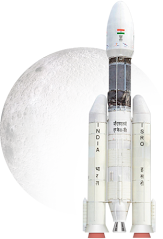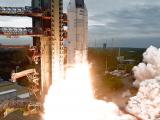CHANDRAYAAN-2 Spacecraft Information
GEOSYNCHRONOUS SATELLITE LAUNCH VEHICLE MARK-III (GSLV MK-III)
Its Components are:
ORBITER:
Chandrayaan-2 orbiter is capable of communicating with Indian Deep Space Network at Byalalu as well as the Vikram Lander. The Orbiter Higher Resolution Camera(OHRC) on board the craft has acquired 22 images of the lunar surface covering nearly 1056 sq km area. It is also used to characterize landing sites for future missions.
Weight : 2379 kg
Electric Power Generation Capability: 1000 W
Lander - Vikram:
The Lander of Chandrayaan-2 was named Vikram after Dr. Vikram A Sarabhai, the father of the Indian space Programme. It was designed to function for one lunar day, which is equivalent to 14 Earth days. Vikram Lander was targetted for a highland smooth plain about 600 kilometers from the south pole. Unfortunately, Vikram lander had attempted to make a soft landing on the south pole of the Moon. ISRO lost contact with the Vikram lander, a few minutes before it was supposed to land at the designed spot.
Weight: 1471
Rover - Pragyan:
Pragyan was the Rover of Chandrayaan -2, a lunar mission developed by ISRO. Pragyan was destroyed along with its Lander Vikram when it crashed - Landed on the Moon in Sep 2019. It was the 6-wheeled robotic vehicle which translates to 'Wisdom' in Sanskrit.






Comments
Post a Comment